Uses of Mango Fruit, Bark, Leaves, Seeds, Recipes, Remedies, Research
There are very few medicinal trees as versatile as Mango. Unripe, sour, sweet mangoes, mango bark, leaves, root, seed, flower – each of these have different medicinal qualities.
Botanical name- Mangifera indica Linn
Family-Anacardiaceae (Amra kula)
Table of Contents
Medicinal properties
Mango medicinal Properties:
Rasa- Kashaya (Bark, Seeds)
Guna- Laghu – light to digest
Vipaka- Katu – Undergoes pungent taste conversion after digestion
Veerya – Sheeta – Coolant
Effect on Tridosha
Ripen fruit – Balances Vata Dosha
Other parts – Kapha Pitta hara – Balances Kapha and Pitta Dosha.
Common types of mango, properties
Kalmi Aam, Kalmi Mango:
It is a sweet dominant mango.
Taste: sweet, rarely sour
Qualities: Heavy, unctuous, cold
Vipaka: sweet
Effect on Tridosha: Balances Pitta and Vata Doshas, Promotes Kapha.
Apakvaphala – Tridoshakaraka
Action – Pakvaphala – Vrishya, Hridya, Balya, Varnya, Ruchya
Apakvaphala – Ruchya
Pharmacological Action – Cardiotonic, Anti fungal, Anti bacterial, Anti tumor, Anti oxidant, Diuretic
Safeda Mango, Safeda aam:
It is sweet, but slightly sour.
The sour quality makes this mango type to be slightly Pitta and Kapha increasing and Vata balancing.
If any type of mango is sour dominant, like Totapuri, then it will be hot. It would improve digestion strength, increase Pitta and marginally increase Kapha and balance Vata Dosha.
Sweetness makes the mango tend towards Pitta calming, nourishing and cooling.
Sourness makes the mango tend towards more hotness and Pitta increasing.
Part used, dosage
Part used– stem bark, leaf, flower, seed kernel
Dosage:
Fresh juice 10-20 ml;
Decoction 50-100 ml
Seed Powder 3-6 g

Ayurvedic home remedies
Home Remedies Using Different Mango Parts: Diarrhea, Eczema, Hair Loss.
Mango recipes and mango chutneys are famous worldwide. In the text books of Ayurveda, Mango has been explained as an effective herbal medicine to treat various disorders. Here are some home remedies using mango recipes
Hair loss – Oil prepared from mango seed is applied over the scalp to treat hair loss and excessive hair fall.
Diarrhea – two tea-spoon full of the kernel of mango seed are cooked with one glass of water and the mixture is made into a semisolid paste form. This is given along with curd, thrice a day.
Stomach pain, diarrhea and vomiting – 10 fresh soft leaves of mango are added with 1-2 black pepper seeds and made into a paste with water and consumed.
Skin disorders, eczema etc. -10 grams of mango flowers and 10 gram of sugar are added to 100 ml of water and boiled. This mango recipe helps in many skin conditions like eczema.
Wound- Gum of mango is traditionally applied over the wound for quick healing.
Skin discolouration: a paste of tender leaves of jamun tree (Eugenia jambolana) and mango leaves, with two turmeric pieces, along with fresh jaggery, macerated with water of curds imparts natural color to the discolored area;
Mango tea – 10 mango leaves that have turned yellow are taken, added to half a liter of water along with 1-2 cardamom. Boil it till the water is reduced to half. Then add sugar and Milk in sufficient quantity and drink it as usual tea. This is beneficial in energizing the body. It acts as a good stimulant.
Note:
The kernel of the seed of mango mitigates Pitta and kapha.
Unripe mango fruit is not suitable for health.
Ripe mango fruit mitigates Vata and Pitta.
Flowers act as a coolant, and are especially beneficial in urinary disorders.
Seed oil balances Kapha and Vata.
Considering all the fruits in general, Fruits which are completely ripened are considered to be the best except the bilva fruit because it is said to be superior in its unripe state.
Sanskrit verse
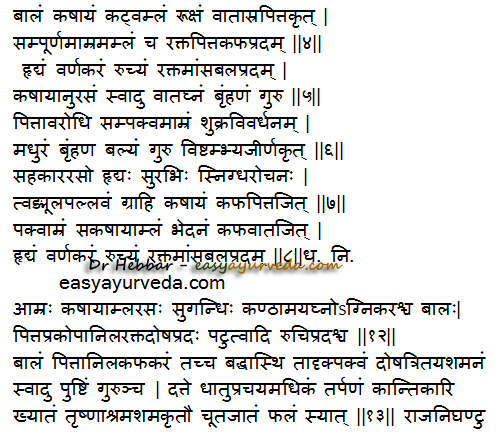
Unripe mango properties
Unripe mango qualities and uses:
Katu – pungent
Kashaya – Astringent
Amla – Sour taste
Rooksha – dry
Ruchya – improves taste, useful in anorexia
Vatasrakrut – vitiates Vata Dosha and blood tissue
Pittakrut – Increases Pitta Dosha
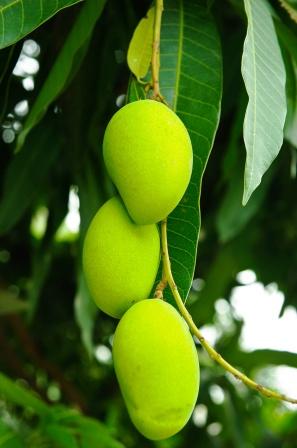
Sour mango uses:
May cause or worsen raktapitta –Bleeding disorders such as nasal bleeding, heavy periods, etc
Asrakrut – vitiates blood
Kaphaprada – increases Kapha
Hrudya – acts as cardiac tonic, congenial for heart
Varnakara – Improves skin tone and complexion
Ruchya – improves taste, relieves anorexia.
Kantamayaghna – useful in throat disorders
Raktamamsabalaprada – improves blood tissue, muscle tissue, strength and immunity.

Sweet mango benefits, indications
Kashayanurasa – has subtle astringent taste
Vataghna – useful in treating disorders of Vata Dosha imbalance such as neuralgia, paralysis, constipation, bloating, etc
Brumhana – nourishing, nutritious
Guru (heaviness)
Pittavarodhi – Does not increase Pitta
Shukravivardhana – improves sperm and semen quantity and quality
Balya – improves strength and immunity
Visthabhya, Ajeernakrut – excess intake may cause constipation and indigestion in a few
Tarpana – Nourishing, calming
Kantikari – improves skin quality
Indicated in:
Trushna – Excessive thirst
Shrama – tiredness
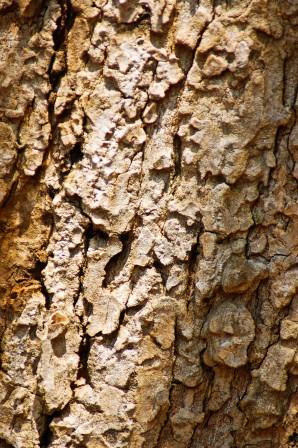
Mango Bark qualities:
Grahi – absorbent, bowel binding, useful in IBS, diarrhea
Kashaya – astringent
Balances Kapha and Pitta Dosha.
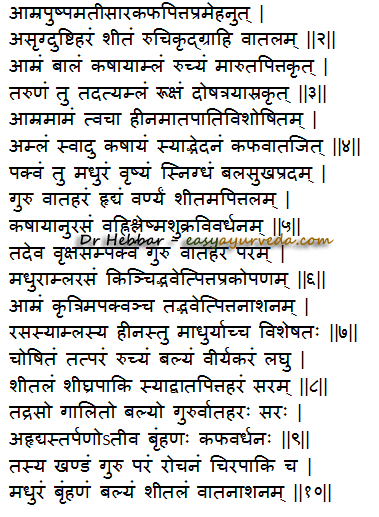
Mango root, shoot qualities
Mango root:
Grahi – absorbent, bowel binding, useful in IBS, diarrhea
Kashaya – astringent
Balances Kapha and Pitta Dosha.
Mango young leaf shoots:
Ruchya – improves taste, useful in anorexia
Grahi – absorbent, bowel binding, useful in IBS, diarrhea
Kashaya – astringent
Balances Kapha and Pitta Dosha.
According to Bhojana Kutuhalam, The peel and the root of mango is astringent in taste, cold in potency and has good fragrance, it helps to improve taste perception and checks diarrhea, The flower imparts taste and stimulates digestive fire, treats diarrhea, prameha, vitiation of pitta and kapha dosha. The mango which is peeled off and properly dried under sunlight is sour, sweet and astringent in taste, loosens the stool and alleviates kapha and vata dosha.
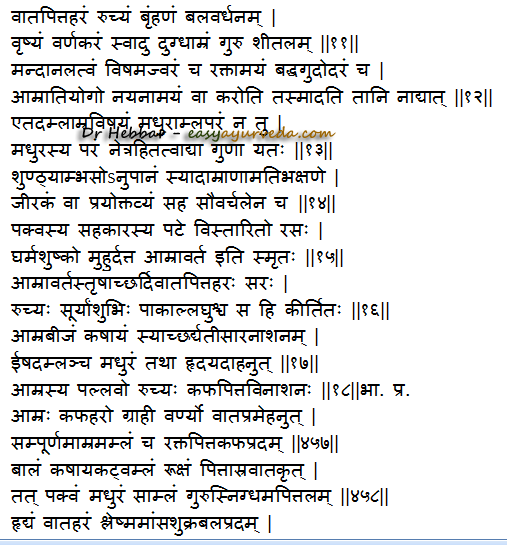
Mango flower
Balances Kapha and Pitta
Asrug Dushtihara – detoxifies blood
Sheeta – cold
Ruchikrut – improves taste, appetizer, useful in anorexia
Grahi – absorbent, bowel binding, useful in IBS, diarrhea
Vatala – Increases Vata Dosha
Indicated in –
Atisara – diarrhea, dysentery
Prameha – Urinary tract disorders, diabetes
Dushta Shonita – vitiated blood
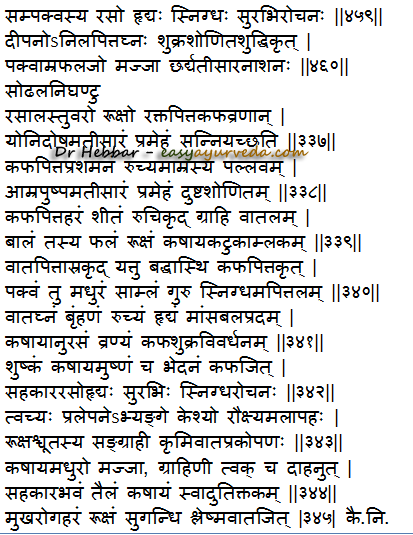
Amchur powder uses
Amchur is prepared by removing the skin of unripe mango and sun-drying.
Amla – sour
Swadu – sweet
Kashaya – astringent
Bhedana – useful in constipation
Kaphavatajit – Balances Kapha and Vata Dosha.
Mango as a fragrant additive:
The dry mango powder added with different food ingredients improves taste perception and alleviates vata dosha. It is heavy and hence thereby weakens the digestive fire, aggravates pitta and kapha.
Vruksha Sampakva Amra
Vruksha Sampakva Amra – Mango that ripens on the tree:
Madhura – sweet
Amla – sour
Guru – heavy
Vatahara – Balances Vata, useful in neurological disorders such as paralysis, hemiplegia, neuropathy etc
Kinchit Pitta Prakopana – slightly increases Pitta.
Krutrima Pakwa Amra
Krutrima Pakwa Amra – Artificially ripened mango:
Has almost no sourness and is very sweet
Laghu – light to digest
Sheetala – coolant
Sheeghrapaki – undergoes quick digestion
Pittanashana – balances Pitta Dosha
Balances Vata and Pitta Dosha
Sara – laxative, promotes movement of liquids in channels
Ruchya – improves taste, useful in anorexia
Balakara – improves strength and immunity
Veeryakara – improves immunity and potency
Galita Amra Rasa
Galita Amra rasa – squeezed mango juice:
Balya – improves strength and immunity
Guru – heavy
Vatahara – Balances Vata, useful in neurological disorders such as paralysis, hemiplegia, neuropathy etc
Sara – laxative, promotes movement of liquids in channels
Brumhana – improves nourishment
Kaphavardhana – Increases Kapha Dosha
Ahrudya – Not good for heart in excess quantities
Mango juice can even be applied over hair to improve shine and strength
Amra Khanda
Amra Khanda – Mango candies:
Guru – heavy
Rochana – improves taste, appetizer
Chirapaki – takes a long time to undergo digestion
Brumhana – improves nourishment
Balya – improves strength and immunity
Sheetala – coolant
Vatahara – Balances Vata, useful in neurological disorders such as paralysis, hemiplegia, neuropathy etc
Sour mango with milk is contraindicated.
Mango milk aphrodisiac recipe video
Dugdhamra
Dugdhamra – Sweet mango with milk:
Vatapittahara – Balances Vata and Pitta Dosha
Ruchya – improves taste, useful in anorexia
Brumhana – improves nourishment
Balavardhana – improves strength and immunity
Vrushya – aphrodisiac
Varnakara – improves skin complexion
Swadu – sweet
Guru – heavy to digest
Sheetala – coolant
Amravarta
Amravarta – Amavat – raw mango cake:
Ripe mango fruits are squeezed to extract juice. The thick juice is spread over a cloth sheet, sun dried. When it dries up, repeated layers of juice is spread and a thick layered mango cake is prepared
It balances Vata and Pitta Dosha
Sara – laxative, promotes movement of liquids in channels
Laghu – light to digest, as it is sun dried.
It is indicated in –
Trushna – Excessive thirst
Chardi – vomiting
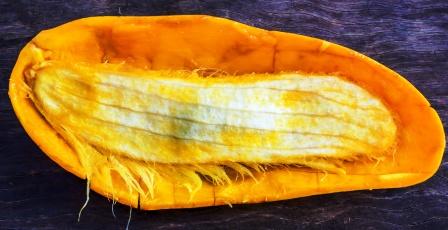
Seed, seed kernel uses
Mango seed uses:
Kashaya – Astringent
Slightly sour and sweet.
Indicated in
Chardi – vomiting
Atisara – diarrhea, dysentery
Hrudayadaha – burning sensation in chest
Seed kernel
Kashaya – astringent
Madhura – sweet
Grahi – absorbent, useful in diarrhea, IBS
Twak dahahara – relieves burning sensation
Proprietary Ayurveda medicines with mango seed as ingredient:
Dysentery tablet – used for the treatment of diarrhea and dysentery.
Mango oil
Oil prepared from Mango:
Kashaya – astringent
Swadu – sweet
Tikta – bitter
Mukharogahara – useful in oral disorders, oral ulcer, bad breath
Rooksha – dry
Sugandhi – has good smell
Pacifies Kapha and Vata
External application:
During excessive bleeding, injury and wounds, bark, flower, leaves and seed kernel dry powders are applied externally. Due to astringent properties, they stop bleeding and heal wounds quickly.
The unripe fruits of mangoes having both sweet and sour tastes, though vitiates the tridosha and the rakta, promotes bone healing in fractures.
The ripe mangoes fruits are sweetish in both their taste and vipaka and hence nourishes the dhatus / tissues by means of its nutritive properties.
The ripe mangoes alleviates the aggravated tridosha and nourishes the malnourished physique. Further, it provides sustaining strength to all the five sense organs.
Due to its pleasant taste it is wholesome and beneficial in patients suffering from parched tongue, thirst and with loss of taste.
The aphrodisiac property of the ripened mango increases the virility of the person and enhances the performance ability.
The mango is considered as the king of all fruits due to their easy availability and their nutritive values.
The sushrutha etc. physicians, almost all of them vouch for the virility promoting, strength promoting, taste promoting, kapha promoting and heavy for digestion properties of the ripened mangoes equivocally without any contradictory opinion.
The fruit juice of the mangoes of different varieties, though may have different varieties of tastes and smell, still do exhibit the above properties mentioned by the Sushruta etc. physicians.
Unripe mango juice
Article by Dr MS Krishnamurthy MD (Ayu), PhD.
Ancient wisdom Ayurveda incorporated several principles of health and nutrition and according to the need it is designed or modified into health drinks and eatables. The scholars of the health science had a deep insight while framing such recipes that the drinks should be fresh, cheaper, easily available, simple, seasonal, tasty, mass acceptable, safe and effective. Hence when compared to today’s cold drinks or soft drinks they appear unique in every respect.
Panaka is one such form of recipe which fulfills the day to day need, especially during summer, which is also the season of various fruits like mango, kokum etc.
In classical formulation of Panaka, tender mango is preferred. Instead, any other suitable fruit can also be considered.
Reference: Bhavaprakasha nighantu/Kritanna varga/151,152
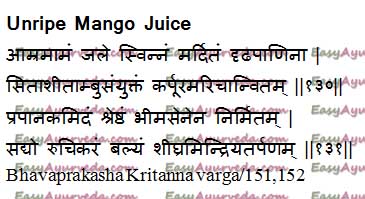
What is Panaka – as per classical version?
Tender mango is taken and it is cooked well in steam. On cooling its outer skin is removed and is macerated well and the pulp is collected. To this, sugar candy and water are added and mixed well. Further, fine powder of camphor and pepper is added and mixed thoroughly.
This is said to be formulated by Legend Bheemasena.
Above preparation is called Panaka or more specifically Amra panaka – unripe mango juice
Qualities:
stimulant, slightly hot, , light (laghu), unctuous (snigdha) and soft (mridu).
Action:
Appetizer (ruchya), energizer (balya), nourisher of the sense organs (indriya balya) and stimulant (uttejaka).
Application:
As it is slightly hot, stimulant and nutritive, this is a drink of choice during winter. Due to sourness it acts as an appetizer, stimulant and anti flatulent. Hence it is useful in indigestion, anorexia, distention of abdomen, lethargy etc.
Read related:Home Remedies Using Different Mango Parts: Diarrhea, Eczema, Hair Loss
Due to its ability of nourishing the sense organs it can be served irrespective of season and age group. It does not have any absolute contraindications and can be served to the needy people as a cool drink at any time of the day.
Side effects
Side effects of Mango:
Excess consumption of sour mango fruit causes:
Mandanala – weak digestion strength
Vishamajwara – recurrent, chronic fever
Raktamaya – blood vitiation disorders like skin diseases, bleeding disorders etc.
Baddhagudodara – constipation and bloating
Nayanamaya – eye disorders
To counter the side effects,
Ginger water is advised or cumin seeds with sochal salt (Sauvarchala Lavana) is advised.
Interaction with medicines, supplements
Can this be used while taking Homeopathic medicine?
Yes. This product does not react with homeopathic medicine.
Can this medicine be continued while taking supplements like multivitamin tablets, Omega 3 fatty acids etc?
Yes. Generally, this product goes well with most dietary supplements. However, if you are taking more than one product per day, please consult your doctor for an opinion.
With western
medicines
Seek your
doctor’s advice if you are taking this product along with other western
(allopathic / modern) medicines. Some Ayurvedic herbs can interact with modern
medicine.
If both Ayurvedic and allopathic medicines are advised together, then it is
best to take Allopathic medicine first, wait for 30 minutes and then take the
Ayurvedic medicine.
Research
Effect of young leaves on GI disorders – such as infection due toE,coliTG1; S.typhi NCTC 74; S. typhi 62; Vibrio cholera 1023 and S. sonnei NK4010
Ayurveda medicines
Ayurveda medicines with mango as ingredient:
Katakakhadiradi Kashayam–Mango seed is used. This is used in treating diabetes.
Nyagrodhadi Churna–used in the Ayurveda treatment for urinary disorders and diabetes
Patrangasav– Seed kernel is used. This medicine is used mainly in gynecological conditions such as heavy menstrual bleeding, leucorrhea, fever etc.
Brihat Gangadhar Churan–Seed is used. It is used in the Ayurveda treatment for Diarrhea and gastrointestinal conditions.
Mangos, raw
पक्वं तु मधुरं साम्लं गुरु स्निग्धमपित्तलम् ||३४०||
वातघ्नं बृंहणं रुच्यं हृद्यं मांसबलप्रदम् |
कषायानुरसं व्रण्यं कफशुक्रविवर्धनम् ||३४१|| (kayyadeva nighantu oshadhivarga 340-341)
Taste – sweet, slightly sour and astringent
Properties – heavy (nourishing, shukravivardhana, balya), unctuous
Potency – cold
After digestion taste transformation (Vipaka) – sweet
Effect on Doshas
Vata balancing
Pitta neutral
Kapha increasing
Chemical composition
Mango chemical Composition –
Leaves and bark contain Mangiferin (flavonoid, natural xanthone C-glycoside), Mangiferolic acid, homonangiferin, indicenol.
Young leaves have tannins, flavonoid, steroid, cardiac glycoside, alkaloids & carbohydrates.
Vernacular names
Names in different languages:
Hindi name- Aam
English name- Mango
Tamil name – maambalam, maankai.
Kannada name – maavinahannu.
Malayalam name – amram, manga, mao, mava.
Urdu name – abanj, amba.
Persian name – amba, ambeh.
Arab name – abanj, abnig, shajratul-anbaj.
Hindi name – aam, amb, amba,amra.
Telugu name – amramu, cutamu, maamidi, maavidi.
Marathi name – aamba, am, amba.
English name – mango.
Classical categorization
Charaka-
Hrudya – Group of herbs that are good for heart,
Chardinigrahana –Antiemetic group of herbs
Purisha sangrahaniya – Group of herbs that increase bulk of feces,
Mutra Sangrahaniya – Group of herbs that increase volume of urine
Sushruta and Vagbhata – nyargodhadi gana
Almost all the Nighantus have mentioned a separate group of herbs starting with Amradi Varga – underlining the importance of Amra in Ayurveda treatment.
Dhanvantari Nighantu, Raja Nighantu, Bhavaprakasha, Sodhala Nighantu – Amradi Varga
Mango nectar, canned
Taste – sweet, slightly sour and astringent
Properties – heavy (nourishing, shukravivardhana, balya), unctuous
Potency – cold
After digestion taste transformation (Vipaka) – sweet
Effect on Doshas
Vata balancing
Pitta neutral
Kapha increasing (more Kapha increasing than raw mango)
Sanskrit Synonyms
Sahakara, Keereshta, Madhavadruma, Bhringabheeshta, Parapushta, Madodbhava, Makanda, Pikabandhava,
Rasala – Juicy,
Atisaurabha – Its flowers has aromatic smell
Chaitravriksha – Plant blossoms in spring season
Madhuphala -On ripening Amra phala will have sweet taste
Amla phala- Fruit has sour taste when it is tender
Vanapushpotsava – densely covered with flowers
Suphala, Madhushchuta, Madhuphala, Seedhurasa, Madhvavasa, Madhuli, – sweet fruit
Vasantadoota, Vasantapadapa – Leaves sprout during Vasanta – spring season
Kamashara, Kamanga, Manmathalaya, Sumadana, Kama vallabha – natural aphrodisiac
Kokilotsava, Kokilabandhu – Nightingale birds sit and sing on mango trees
Varieties
Ra. Ni – 4 types
Kosamra
Rajamra
Maharajamra
Badaramra
Sodhala Nighantu – 3 types
Amra
Rajamra
Kosamra
Morphology
Large spreading evergreen tree
Leaf – crowded at the ends of branches, simple, oblong lanceolate
Inflorescence – Panicle
Flowers – Monoecious
Fruit – Drupe, fleshy, seed is compressed, fibrous, and very hard
Part used – Root, Twak (Bark), Leaf, Flowers, Fruit and seed
Sthanika karma (Systemic Acton)
Externally – The bark, flower, leaves, and seed kernel of this plant exhibit styptic properties and promote wound healing. Those are indicated in diseases due to kapha and pitta dosha imbalance. When the raw mango is subjected to fire processing, it becomes beneficial for patients experiencing excessive thirst. It is indicated in diseases of vata pitta origin
Internally
Digestive system –Fruit has Carminative and improves taste, Ripened fruit facilitates the proper movement of doshas and is unctuous in nature, it is beneficial in conditions like constipation. and has a mild purgative action. Leaves can be used to prevent vomiting. Flower, bark, and seed kernels have styptic properties, so indicated in diarrhea. Seed kernels also have Ant helminthic action, which can be given in helminthiasis. Chutney prepared out of its raw fruit is indicated in Anorexia, Loss of appetite etc.
Circulatory System – Ripened fruit is good for the heart and increases blood count. indicated in bleeding disorders. Its bark, flower, seed kernel are also indicated in bleeding disorders.
Reproductive system – Ripened fruit is Aphrodisiac, and row mango causes rakta pitta kopa. Seed kernel is indicated in menorrhagia and in Leukorrhea.











14 comments
UmaShankari
Dear Shri. Hebbar, I find the articles v. useful. Pl. continue to send them to my mail.
I am a mango farmer from Chittoor dt. of Andhra Pradesh. I am looking at value addition possibilities for mangoes beyond pulp and pickles. The whole region of Chittoor dt. has been planted with mango and the only things farmers know of are pulp and pickles. The pulp factories do not give us good prices, and unbranded pickles have no market. The above article is indicating various uses of mangoes- from root to bark to seeds and kernels. If there is a market for these products, we farmers would like to benefit from them. Pl. write to me in detail how we mango farmers can benefit from raw material markets for ayurveda. My email ID is :[email protected]
Fanuel Chandilanga
Quiet helpful. I have been wasting mangoes, now I now they are precious
m r sreenivasa
excellent. easy to understand and experiment
laxmi
pplease give the methods of preparing medicine for excess of bleeding, with the kernel of seeds.
Dr J V Hebbar MD(Ayu)Author
Its dry fine powder in a dose of half a gram twice a day, with water, after food is advised or its water decoction (Kashaya) is administered in a dose of 15 ml, twice a day after food.
VJ Kumar
excellent! please include more recipes in the future
Vishal
What is the potency of the organic mango, 100% ripe naturally without any calcium carbide ?
Thanks
Dr J V Hebbar MD(Ayu)Author
Cold, if it is sweet in taste.
Sushant Thakur
Respected Dr,
Please clarify the difference between the terms Mangos Raw and Unripe mango, used in the above article. I need a form of Mango which is neutral or pacify Pitta. Please help
Dr J V Hebbar MD(Ayu)Author
Sweet, ripe Mango pacifies Pitta.
Raw mango is the smaller one. Unripe is almost the shape of ripe mango, but is yet to ripe.
Advait
Hello doctor
You have said that Mango can be taken with milk as per your article above
But according to Ayurveda any fruit cannot be consumed with milk as it can cause skin deaseas
Kindly clarify
Dr J V Hebbar MD(Ayu)Author
There are some mixed opinions.
Mango and other sour fruits are contra indicated with milk. But Bhavaprakasha textbook mentions about mango milk recipe for Pitta balance.
Siddharth
Hi,
Pls also mention the dosha characteristics of various varities of mangoes eg kalmi, koshamra, safeda etc
Dr J V Hebbar MD(Ayu)Author
Added in the article above. Look for 3rd paragraph onwards.